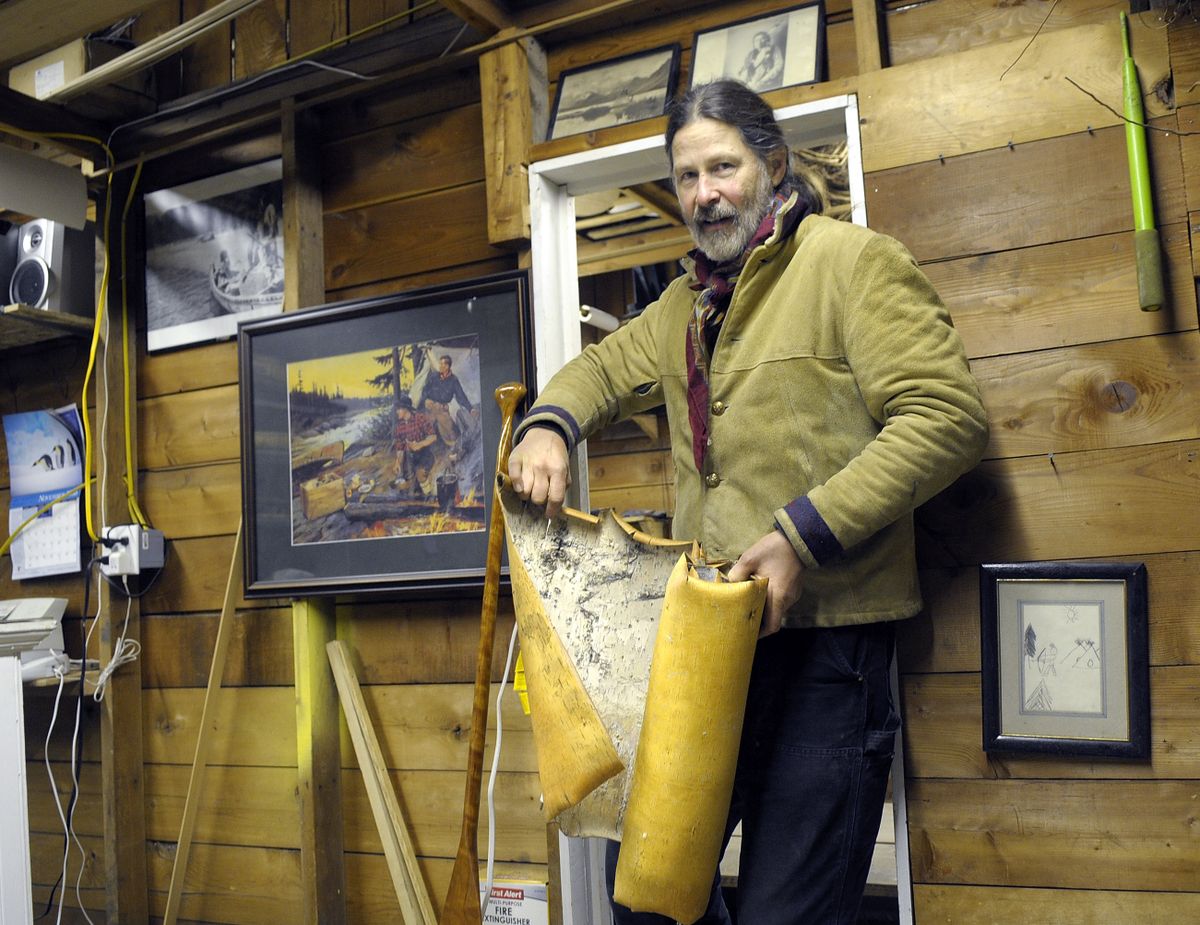Store owner’s craft becomes his job, too
Canoe builder opens online, brick-and-mortar stores; his vessels resemble those from mid-19th century

Stepping into the Bark Canoe Store can be a surreal experience. The small shop, just off busy Division Street, is an oasis of quiet. Woven birch pack baskets hang from one wall. Spruce root dangles from the rafters, and the air is redolent with the scent of wood shavings.
Small decorative canoes line the shelves. Full-size bark and fiberglass canoes in various stages of completion lie in the shop and in the yard behind it.
Store owner John Lindman fits perfectly into this setting. With his beard and graying brown hair pulled into a ponytail, he looks like an outdoorsman in the Philip Goodwin prints that hang on his walls.
“The idea of the shop is to make it look like it’s a hundred years old,” he said. That seems especially appropriate, considering the boats he builds here saw their heyday during the height of the fur trade in the mid-1800s.
However, as a young adult Lindman preferred kayaks to canoes. He enjoyed the adrenalin rush of whitewater kayak racing. But while visiting his parents during a college break, he wanted to spend time on the water. They didn’t have a kayak, but they did have an aluminum canoe. He took the boat out on the Spokane River, where he discovered faster isn’t always better.
“Canoeing is like meditation,” he said. “It’s better than walking or biking. I can be all wrapped up in stuff and get out on a river and be in the present moment.”
The solitary stillness and the intimacy with the environment, combined with the technical skill needed for navigation, made Lindman a canoeing convert.
Though he left Spokane to attend the University of Washington and then pursued a career in the dot-com industry, his love of natural beauty and passion for the outdoors stayed with him.
In 1992 he attended a bark-canoe building class in Wisconsin and found a hobby that eventually became his livelihood. “The ultimate for me is the birch bark canoe,” Lindman said. “It’s the ultimate immersion into the environment.”
As he became involved in canoe building, he discovered a problem: lack of easily obtainable supplies. So he launched the online Bark Canoe Store in 2000. “I wanted to create a hangout for those who are really interested in this,” he said.
An unexpected layoff from his job overseeing software sales prompted Lindman to return to Spokane in 2003 and develop his hobby into a full-time business.
His virtual store expanded into a brick-and-mortar store in 2005. Lindman builds fiberglass birch bark canoe replicas, as well as the traditional canoes. He sells pack baskets and paddles, made in Maine, and has found a market for materials such as bark, twigs and saplings, which he sells to furniture makers and birch bark crafters.
Lindman imports the bark from Siberia, because he’s found the Siberian wood to be much more pliable and less fragile than its North American counterpart.
The process of crafting a canoe is labor-intensive and exhausting.
“It’s like trying to keep up with a 2-year -old,” Lindman said.
Yet he enjoys the artistic and innovative facets of the business. And Lindman’s creations have ended up in far-flung places.
“The first canoe I ever made is hanging in the Silver Bullet Bar in Bad Gastein, Austria,” he said. A fellow he’d taught at a bark canoe building workshop sent him a snapshot of him paddling his canoe on a lake in Geneva, Switzerland. Once, while traveling, Lindman stopped at a Bass Pro Store in Indiana and found one of his canoes hanging over the entrance. His boats have been featured in the PBS documentary “The War that Made America,” the movie “Dream Keeper” and a French-Canadian miniseries.
Every vessel is unique. “They’re mostly sold as art,” Lindman said. “But each one is built so they can be paddled on the water.”
And Lindman is still teaching others how to build boats. He conducts several workshops each year and frequently teaches the craft at private summer camps in the U.S. and Canada.
“As a kid I was fascinated with American-Indian culture,” he said.
While teaching his first class, Lindman got to experience an Indian culture firsthand. He was invited to Alaska to reintroduce the craft to a group of Kenai Indian teens. The skill of canoe making has faded from the Kenai way of life.
Said Lindman: “I was giving back what was taken away.”